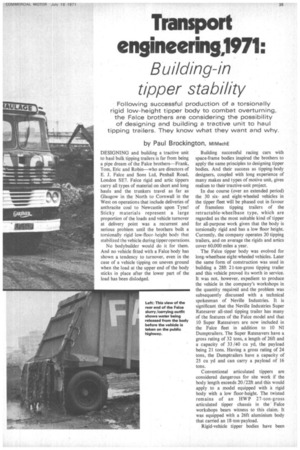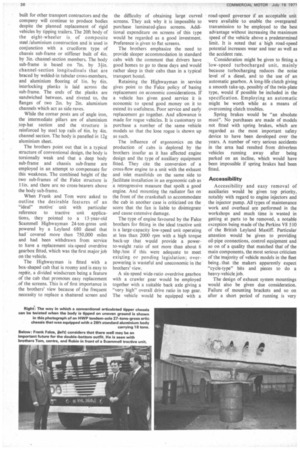Transport engineering:1971:
Page 37

Page 38

Page 39

If you've noticed an error in this article please click here to report it so we can fix it.
B tipper stability
Following successful production of a torsionally rigid low-height tipper body to combat overturning, the Falce brothers are considering the possibility of designing and building a tractive unit to haul tipping trailers. They know what they want and why.
by Paul Brockington, MIIVlechE
DESIGNING and building a tractive unit to haul bulk tipping trailers is far from being a pipe dream of the Falce brothers—Frank, Tom, Eric and Robin—who are directors of E. J. Falce and Sons Ltd. Penhall Road, London SE7. Falce rigid and artic tippers carry all types of material on short and long hauls and the trunkers travel as far as Glasgow in the North to Cornwall in the West on operations that include deliveries of anthracite coal to Newcastle upon Tyne! Sticky materials represent a large proportion of the loads and vehicle turnover at delivery point was a recurrent and serious problem until the brothers built a torsionally rigid low-floorheight body that stabilized the vehicle during tipper operations.
No bodybuilder would do it for them. And no vehicle fitted with a Falce body has shown a tendency to turnover, even in the case of a vehicle tipping on uneven ground when the load at the upper end of the body sticks in place after the lower part of the load has been dislodged. Building successful racing cars with space-frame bodies inspired the brothers to apply the same principles to designing tipper bodies. And their success as tipping-body designers, coupled with long experience of many makes and types of motive unit, gives realism to their tractive-unit project.
In due course (over an extended period) the 30 sixand eight-wheeled vehicles in the tipper fleet will be phased out in favour of frameless tipping trailers of the retractable-wheelbase type, which are regarded as the most suitable kind of tipper for all-purpose work given that the body is torsionally rigid and has a low floor height. Currently, the company operates 20 tipping trailers, and on average the rigids and attics cover 60,000 miles a year.
The Falce tipper body was evolved for long-wheelbase eight-wheeled vehicles. Later the same form of construction was used in building a 28ft 21-ton-gross tipping trailer and this vehicle proved its worth in service. It was not, however, expedient to produce the vehicle in the company's workshops in the quantity required and the problem was subsequently discussed with a technical spokesman of Neville Industries. It is significant that the Neville Industries Super Ratesaver all-steel tipping trailer has many of the features of the Falce model and that 10 Super Ratesavers are now included in the Falce fleet in addition to 10 NI Dumptrailers. The Super Ratesavers have a gross rating of 32 tons, a length of 26ft and a capacity of 33/40 cu yd, the payload being 21 tons. Having a gross rating of 24 tons, the Dumptrailers have a capacity of 25 cu yd and can carry a payload of 16 tons.
Conventional articulated tippers are considered dangerous for site work if the body length exceeds 20/22ft and this would apply to a model equipped with a rigid body with a low floor-height. The twisted remains of an HWP 27-ton-gross articulated tipper chassis in the ' Falce workshops bears witness to this claim. It was equipped with a 26ft aluminium body that carried an 18-ton,payload.
Rigid-vehicle tipper bodies have been built for other transport contractors and the company will continue to produce bodies despite the planned replacement of rigid vehicles by tipping trailers. The 20ft body of the eight-wheeler is of composite steel /aluminium construction and is used in conjunction with a cruciform type of chassis sub-frame or stiffener built of 4in. by 3in. channel-section members. The body sub-frame is based on 7in. by 3i-in. channel-section longitudinals that are braced by welded-in tubular cross-members, and aluminium flooring of lin. by 6in. interlocking planks is laid across the sub-frame. The ends of the planks are sandwiched between, and riveted to, the flanges of two 2in. by 2in. aluminium channels which act as side raves.
While the corner posts are of angle iron, the intermediate pillars are of aluminium top-hat section and the structure is reinforced by steel top rails of 6in. by 4in. channel section. The body is panelled in 12g aluminium sheet.
The brothers point out that in a typical structure of conventional design, the body is torsionally weak and that a deep body sub-frame and chassis sub-frame are employed in an attempt to compensate for this weakness. The combined height of the two sub-frames of the Falce structure is I1M. and there are no cross-bearers above the body sub-frame.
When Frank and Tom were asked to outline the desirable features of an "ideal" motive' unit with particular reference to tractive unit applications, they pointed to a 13-year-old Scammell Highwayman 24-ton-gross unit powered by a Leyland 680 diesel that had covered more than 750,000 miles and had been withdrawn from service to have a replacement six-speed overdrive gearbox fitted, which was the first major job on the vehicle.
The Highwayman is fitted with a box-shaped cab that is roomy and is easy to repAir, a divided windscreen being a feature of the cab that promotes easy replacement . of the screens. This is of first importance in the brothers' view because of the frequent necessity to replace a shattered screen and the difficulty of obtaining large curved screens. They ask why it is impossible to purchase laminated-glass screens. Additional expenditure on screens of this type would be regarded as a good investment. Preference is given to flat screens.
The brothers emphasize the need to provide sleeper accommodation in standard cabs with the comment that drivers have good homes to go to these days and would rather sleep in their cabs than in a typical transport hostel.
Retaining the Highwayman in service gives point to the Falce policy of basing replacement on economic considerations. If a vehicle has given good service it is economic to spend good money on it to extend its usefulness. Poor service and early replacement go together. And allowance is made for rogue vehicles. It is customary to purchase a number of the same vehicle models so that the lone rogue is shown up as such.
The influence of ergonomics on the production of cabs is deplored by the brothers insofar as it has affected engine design and the type of auxiliary equipment fitted. They cite the conversion of a cross-flow engine to a unit with the exhaust and inlet manifolds on the same side to facilitate installation in an ergonomic cab as a retrogressive measure that spoilt a good engine. And mounting the radiator fan on the front of the crankshaft to accommodate the cab in another case is criticized on the score that the fan is liable to disintegrate and cause extensive damage.
The type of engine favoured by the Falce brothers for fitting in the ideal tractive unit is a large-capacity low-speed unit operating at less than 2000 rpm with a high torque back-up that would provide a powerto-weight ratio of not more than about 6 bhp /ton if this were adequate to meet existing or pending legislation; overpowering is wasteful and uneconomic in the' brothers' view.
A six-speed wide-ratio overdrive gearbox with a crawler gear would be employed together with a suitable back axle giving a -very high" overall drive ratio in top gear. The vehicle would be equipped with a
road-speed governor if an acceptable unit were available to enable the overgeared transmission to be employed to the best advantage without increasing the maximum speed of the vehicle above a predetermined limit. It is noted that a' high road-speed potential increases wear and tear as well as the accident rate.
Consideration might be given to fitting a low-speed turbocharged unit, mainly because turbocharging reduces the noise level of a diesel, and to the use of an automatic gearbox. A long-life clutch giving a smooth take-up, possibly of the twin-plate type, would if possible be included in the specification. Employing an automatic might be worth while as a means of overcoming clutch troubles.
Spring brakes would be "an absolute must". No purchases are made of models not fitted with spring brakes, which are regarded as the most important safety device to have been developed over the years. A number of very serious accidents in the area had resulted from driverless vehicles running away after being parked on an incline, which would have been impossible if spring brakes had been fitted.
Accessibility Accessibility and easy removal of auxiliaries would be given top priority, notably with regard to engine injectors and the injector pump. All types of maintenance work and overhaul are performed in the workshops and much time is wasted in getting at parts to be removed, a notable exception being made of the Perkins V8 510 of the British Leyland Mastiff. Particular attention would be given to providing oil-pipe connections, control equipment and so on of a quality that matched that of the main components. the most serious criticism of the majority of vehicle models in the fleet being . that the makers apparently expect "cycle-type" bits and pieces to do a heavy-vehicle job.
The design of exhaust system mountings would also be given due consideration. Failure of mounting brackets and so on after a short period of running is very common.
Scammell Rout eman eight-wheelers form the majority of the rigid fleet while the remainder comprises Leyland Octopus, Guy Warrior, Guy Big 3 and Bedford KM eightand six-wheelers. Tractive units are either 32-ton-gross or 24-ton machines. All but one of the bigger vehicles are Scammell Trunkers, the loner being a Volvo FB88. The trunkers are powered by Leyland 680 diesels with the exception of one vehicle equipped with a Rolls-Royce Eagle, the gearboxes being Thornycroft six-speed overdrive units. Apart from the veteran Highwayman, the 24-ton tractive units are Mastiffs fitted with ENV five-speed gearboxes and Eaton two'-speed axles.
Bodybuilding and major overhauls of mechanical components, including engines, are concentrated at the Hawley Road, Dartford, depot of the company and there is a third depot at Roan Street, Greenwich. Maintenance is based on the Shell Servo planned fleet maintenance system which is fully comprehensve and strictly adhered to. Shell Rotella T30 oil is used to lubricate all the engines and is changed at intervals of not more than the /recommended interval. Employing a high-grade costly oil is cited as a practice that pays off handsomely in the long run in terms of engine life. Michelin radial tyres are, in the main, fitted to the wheels of non-driving axles, driving axles being equipped with crossply tyres.
In an appraisal of possible trends and developments, Frank considers that the double-bottom combination would be economically viable for trunking runs if a gross weight of 46 tons were allowed. Based on two identical semi-trailers, the outfit could be split up at the terminals and the second trailer coupled to another tractive unit for local delivery to a different destination. While the power of the tractive unit engaged on trunking runs would have to be around 300 bhp, a unit powered by a smaller engine could be used to haul the second trailer on local runs.




























































































